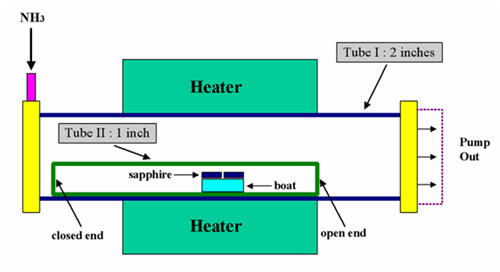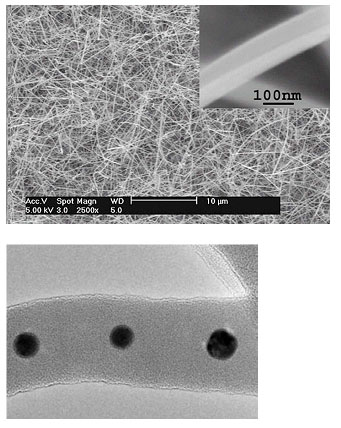|
2. Result
The synthesis of the nanowires is follow the vapor-liquid-solid mechanism and conducted by using a tubular furnace. Figure 1 is schematic diagram of our equipment. Heating and cooling the source with adequate amount of ambient gas, the nanowires can be synthesized. Figure 2 shows the various kinds of nanowires of our group. These nanowires also have magnetic property which was shown in figure 3.

Fig. 1. schematic diagram of apparatus

Fig. 2. The images of nanowires

Fig. 3. The magnetic properties of nanowires
3. Future plan
Until now, our group focused only to synthesize of DMS nanowires. We try to synthesize more better nanowires with the change the dopants and experiments conditions. And besides the nanowires, nanoparticles, especially iron oxide, can be a candidate for a new target for our group.
4. References
1. C. Xu, J. Chun, and D. Kim, B. Chon and T. Joo, ˇ°Structural characterization and low temperature growth of ferromagnetic Bi-Cu codoped ZnO bicrystal nanowiresˇ±, APPLIED PHYSICS LETTERS 97, 153104 (2007)
2. CongKang Xu, Junghwan Chun, Dong Eon Kim, Ju-Jin Kim, Bonghwan Chon, and Taiha Joo, "Electrical properties and near band edge emission of Bi-doped ZnO nanowires", APPLIED PHYSICS LETTERS 90, 083113 (2007)
3. CongKang Xu, Junghwan Chun, Hyo Jin Lee, Yoon Hee Jeong, Seong Eok Han, Ju-Jin Kim, and Dong Eon Kim, "Ferromagnetic and Electrical Characteristics of in Situ Manganese-Doped GaN Nanowires", J. Phys. Chem. C 111, 1180-1185 (2007)
4. CongKang Xu, Junghwan Chun, Bonghwan Chon, Taiha Joo and Dong Eon Kim, "In situ fabrication and blueshifted red emission of GaN:Eu nanoneedles", Nanotechnology 18, 015703 (2007)
|

